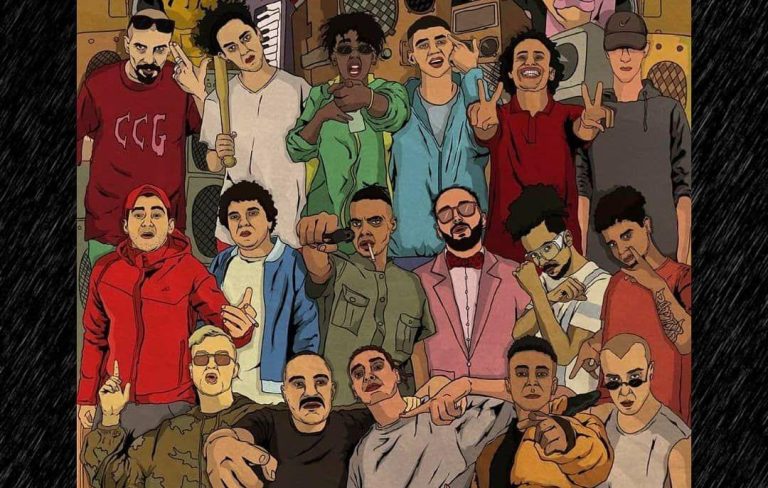What began as an underground experiment has become Egypt’s most dynamic musical force.
Over the past two decades, rap in Egypt has evolved from whispered rhymes in small studios to a cultural language that defines a generation. It’s a story of persistence and reinvention — from early pioneers recording on pirated software to global hits streaming across millions of devices.
Egyptian rap didn’t just grow; it adapted, survived, and thrived — reflecting the country’s shifting social pulse with every beat.
Early Echoes: The Birth of Egyptian Rap
Rap first appeared in Egypt in the late 1990s, long before it had an audience or industry. Inspired by American hip-hop but deeply local in content, small groups of young Egyptians began experimenting with rhythm, rhyme, and colloquial Arabic to express their realities.
The first rap groups were Y Crew — founded in 1998 by Yassin Zahran and Omar Boflot in Alexandria — and MTM known for “Omy Mesafra”, who fused humor and Egyptian slang with upbeat rhythms. Both groups broke new ground, crafting lyrics that spoke to Egyptian daily life rather than imitating Western styles.
At the time, rap was dismissed as strange and foreign. But even in its obscurity, it resonated with a few who saw it as a tool for honesty — a way to turn frustration into poetry.
Rap Enters the Screen: Cinema and Early Recognition
As rap slowly grew underground, Egyptian cinema began to notice.
- In 2008, Waraqat Shifra became one of the first films to feature a rap song on its soundtrack.
- That same year, Ahmed Mekky, then a rising actor and writer, released “Ged3an taybeen” for his film H Dabour.
Mekky brought rap into the mainstream. Through songs like“Dawar Benafsak,” “Facebooky” , and “Atr al Hayat,” he introduced rap to everyday Egyptians — infusing it with humor, national pride, and social reflection.
Then came Microphone (2010), directed by Ahmad Abdalla. The film featured Shahyn and other Alexandrian rappers, portraying Egypt’s underground scene for the first time. It was a cinematic acknowledgment that rap had become more than a niche — it was a movement in progress.
The Alexandria Genius: Shahyn and the First Wave
Among these early innovators stood Shahyn, often called “the genius of Alexandria.”
He began rapping at just 13, joining Y Crew in the mid-2000s. His lyrics blended wit, realism, and melancholy, speaking about identity, struggle, and the street’s poetry. With limited tools and no formal industry, Y Crew still built a loyal underground following — becoming a symbol of artistic resilience.
Shahyn’s style — deeply lyrical and introspective — represented what many now call Egypt’s “first serious rap wave.” Alongside artists like MTM, Ahmed Mekky, and Omar Boflot, he helped turn rap from imitation into identity.
The Pause: Old School Ends, A New Era Begins
Throughout the early 2010s, Shahyn remained a central voice. His songs were marked by precision, reflection, and old-school integrity. But in 2016, following his father’s death, he withdrew from the scene, moving to Dubai and leaving behind the world he’d helped shape.
In his absence, Egyptian rap underwent a transformation. A younger generation emerged — fluent in digital tools, inspired by trap, and unafraid to experiment. The underground was about to explode.

The Rap Revolution: The Joker, Abyusif, and Trap Foundations
Abyusif emerged as a fearless innovator, known for his bold experimentation in both sound and visuals. His track “3azra2eel” became a standout — its unconventional lyrics and visually striking video capturing the chaotic, artistic edge that defines his style.
His relentless output made him a cult figure — and a mentor figure to the new wave that followed.
The Joker (Ahmed Nasser) was another pivotal voice. Starting his career in 2011, he’s often seen as one of the first true trap artists in Egypt.
Known for his razor-sharp writing and philosophical tone, he used rap to deliver social critique and self-reflection. Despite frequently disappearing from the scene, his returns — with tracks like “RAKAM 1 DA MESH ENTA” and “Sokan El Leel” — reminded listeners of his depth and command.
Other figures — like Zap Tharwat & Asphalt also kept the underground alive, merging social activism with rhythm and rhyme. Together, they carried Egyptian rap through its transitional years.
The Modern Wave: Trap, Freedom, and Digital Fame
By the mid-to-late 2010s, rap in Egypt had found its second wind.
Platforms like YouTube and SoundCloud turned local artists into overnight sensations. The sound became bolder, faster, and digitally driven, influenced by global trap but grounded in Egyptian dialect.
At the center of this wave stood Marwan Pablo, Wegz, Marwan Moussa, Afroto, and Abu Al Anwar.
- Marwan Pablo captured the restless spirit of youth. His songs “Free” and “Barbary” became generational anthem, blasting from cafés and tuk-tuks across Egypt.
- Wegz combined street poetry with emotional rawness. Songs like “Tayeh,” “Al Bakht,” and “Man7os” dominated the airwaves, while his collaboration with Molotof in “Dorak Gai” reshaped the sound of Egyptian rap.
- Marwan Moussa and Afroto added their own creative edge — sharp humor, melodic experimentation, and a confident, local sound.
This cultural boom began with two songs that changed everything: Pablo’s “EL GEMEZA” and Wegz’s “Bazeet.” They didn’t just trend; they transformed the genre’s social reach.
The underground had officially become the mainstream.
The Rust-Proof Antique: Shahyn’s Return
Just as the new scene hit its peak, Shahyn reappeared — not as a relic, but as a reborn artist.
After years in Dubai, he returned to Alexandria, leaving behind a stable job and shedding the label of “genius.” He faced a new world where “old school” was out of style — but he adapted.
Shaheen embraced the new scene, rapping, “I am the oldest among you — the antique.” His comeback tracks — “Bestek now,” “Ma 3aleena,” and especially “Siri” — proved his evolution. He blended lyrical discipline with modern trap energy, winning back both longtime fans and new listeners.
Shahyn’s return was more than nostalgia — it was proof that rap in Egypt had matured enough to celebrate its past while moving forward.
From Margins to Mainstream
Now, rap in Egypt is everywhere — in ads, festivals, films, and fashion. Artists like Wegz, Pablo, Abyusif, Marwan Moussa, Shahyn, and Afroto headline concerts around the world and collaborate with global brands.
But the pioneers — Mekky, The Joker, Omar Boflot, MTM — remain the backbone of this culture. Their risk-taking built the platform on which the new generation stands.
The story of Egyptian rap is not a competition between generations but a conversation between them. Each wave built upon the last, keeping the movement alive while pushing it forward. What began in small rooms and makeshift studios has turned into a nationwide phenomenon, but its soul remains rooted in honesty and defiance. Egyptian rap continues to evolve — old voices adapting, new ones rising, all speaking the same language of truth.
WE ALSO SAID: Don’t Miss…Tracing The Beat: How Shaabi Music Emerged And Evolved



